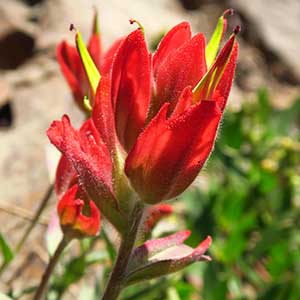Castilleja lineata
Castilleja elmeri
linear-lobed paintbrush, lineated paintbrush, marsh-meadow Indian paintbrush
Elmer's Indian paintbrush, Elmer's paintbrush, Wenatchee Indian paintbrush, Wenatchee paintbrush
few to many, erect or strongly ascending, unbranched except for small, leafy axillary shoots, hairs spreading-reflexed to ± appressed, matted, long, soft, with much shorter stipitate-glandular ones, white-woolly.
solitary or few to many, erect to ascending, sometimes slightly curved at base, unbranched, rarely branched, hairs moderately dense, spreading, medium length, soft, mixed with shorter eglandular and stipitate-glandular ones, at least on distal 1/2 of stem.
green, linear to narrowly oblong or narrowly lanceolate, 1.3–5 cm, not fleshy, margins plane, sometimes wavy, involute, 3–7-lobed, apex acute;
lobes divergent, spreading-ascending, linear, apex acute to acuminate.
green, rarely purple-tinged, linear-lanceolate, sometimes linear or lanceolate, 1.3–6.5 cm, not fleshy, margins plane, flat or involute, entire, apex acute.
5–22 × 1–4.5 cm;
bracts green to yellow-green throughout, or proximally green to yellow-green, distally yellow to sometimes pale yellow-orange, narrowly lanceolate to narrowly oblong or broadly lanceolate, 3(–7)-lobed;
lobes ascending to spreading, linear to oblong, medium length to long, arising near or below mid length, central lobe apex rounded to obtuse, lateral ones acute.
2.5–9 × 1.5–3 cm;
bracts red, crimson, scarlet, pink, magenta, red-orange, burnt orange, orange, pale yellow, or whitish throughout, or proximally greenish, distally as stated above, oblong, narrowly obovate, elliptic-oblong, or narrowly ovate, 0(–5)-lobed, rarely with 1 or 2 pairs of short, usually distal lobes;
lobes ascending, lanceolate, very short, arising from distal edge, apex rounded to obtuse.
0 mm.
straight or slightly curved, 14–22 mm;
tube 7–14 mm;
beak tip barely exserted from calyx;
beak adaxially greenish, 4–7 mm;
abaxial lip green to yellow, reduced, 1–4 mm, usually less than 67% as long as beak;
teeth erect, white to yellow, 1–2.5 mm.
straight, 20–33 mm;
tubes 13–18 mm;
beak, and sometimes abaxial lip, partially to fully exserted;
beak adaxially green to yellowish, 8–15 mm;
abaxial lip incurved, green, thickened, 2–3 mm, 20–33% as long as beak;
teeth ascending or incurved, green, 0.5–1 mm.
colored as bracts, 15–20 mm;
abaxial and adaxial clefts 5.5–8 mm, 30–50% of calyx length, ± deeper than laterals, sometimes appearing subequal in pressed specimens, lateral 5–6 mm, ca. 33% of calyx length;
lobes linear to narrowly lanceolate, sometimes expanded towards apices, apex acute.
proximally green to pale green, distally colored as bracts, 15–25 mm;
abaxial and adaxial clefts 5–14 mm, 33–50% of calyx length, deeper than laterals, lateral 1–4 mm, 6–20% of calyx length;
lobes lanceolate to narrowly triangular, apex rounded to obtuse.
= 24.
= 48.
Castilleja lineata
Castilleja elmeri
Castilleja lineata is restricted to the mountains of northeastern Arizona, southern Colorado, and northwestern New Mexico. It is uncommon throughout its range and is without apparent close relatives. The Navajo used C. lineata as a medicinal plant and for its sweet nectar (D. E. Moerman 1998).
(Discussion copyrighted by Flora of North America; reprinted with permission.)
The bracts and inflorescences of Castilleja elmeri can be red, crimson, scarlet, pink, magenta, red-orange, burnt orange, orange, pale yellow, or whitish. While the coloration is highly variable between local populations, it is usually uniform and consistent within them. It is found primarily in the Wenatchee Mountains of Washington, where it is often on serpentine, but it ranges northward in the Cascades into extreme southern British Columbia, apparently on non-serpentine substrates. Hybrids with C. miniata var. miniata, C. parviflora var. albida, and C. thompsonii have been found in the eastern Cascades of Washington, and a similar hybrid swarm with C. thompsonii is reported from southern British Columbia.
(Discussion copyrighted by Flora of North America; reprinted with permission.)


